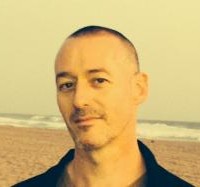For many years, I was captivated by the idea of not being my body.
The truth is, it can seem so appealing!
The belief from many traditions is that we suffer precisely because we identify with our bodies, and that freedom is (somehow) somewhere beyond that mistake. But what I found over the years is that in fact the opposite might be true: we suffer when we do not embrace our bodies, and in fact it is our suffering in the first place that makes us reject, disconnect from and seek to be somewhere other than our bodies.
Healing lies in coming home to the body. Whether it is recovery from trauma, abuse or addiction, learning to manage stress and be present with feelings, or releasing shame and media-conditioning to embrace our bodies as they are.
Back then, I was seeking the “out of body experience.”
I wanted to transcend the limitations of time and space, and go beyond everything I didn’t like about the world and my life.
Over time, I came to see that this was actually an expression of my suffering—my trauma. It was a reaction to the fact that life was hard, difficult things happened and painful, sometimes unbearable emotions arose. Over time I came to see that this was a central feature of the human experience, and that how we deal with it is so important.
Because I didn’t yet have the integrated spiritual tools I would later learn and share, escapist spirituality seemed like the only option.
A spirituality that promised divine perfection, otherworldly enlightenment, complete freedom from suffering and a way of simply transcending the whole messy, screwed up world sounded really good to a kid who grew up under Apartheid in South Africa, went to a school system that enacted corporal punishment (caning) for misbehavior or poor test scores, and struggled through the dysfunction of my family of origin
But what I gradually realized was this: no matter how profound the spiritual experience or far-out belief system, the world simply doesn’t go anywhere!
Our psychological issues, emotional vulnerabilities, and trauma history seem to actually remain untouched by spiritual beliefs and practices that disconnect us from reality, our bodies and our feelings.
In fact, this may represent the spiritual awakening I actually had—which was not what I was expecting: healthy spirituality empowers us to deal with our bodies, feelings and the world in compassionate and honest ways, rather than enacting denial, avoidance or escapism.
In additional to cultivating clarity of mind, open-heartedness and joy, the way of the grounded spiritual warrior lies through the heart of suffering. It lies in the shadow of what we avoid and fear, and in finding compassion for the parts of us that are hurting. Most of all it lies in the simple wisdom of recognizing that we experience our lives through our bodies, and that practices that enable us to be awake and aware in our bodies provide an opportunity for deeply meaningful inner work.
I sometimes talk now about yoga as a way to more fully inhabit every room in the mansion of your being; of opening boarded doors and windows, clearing out cobwebs and letting the light stream in.
Vipassana meditation created that experience in my yoga practice. It is about holding a loving, open awareness of your body moment by moment as you sit in silence. Bringing your mind back again and again to your sensations, with gentle but disciplined curiosity. In time, the way sensation, emotion, and thought are woven together in the mind-body connection reveals itself, and powerful changes start to occur.
Interestingly, the word “vipassana” means “insight”—so the idea is literally that insight into our lives and the human condition emerges from being deeply aware of our bodies. Embodied enlightenment!
When I was first exposed to Buddhist vipassana meditation via Jack Kornfield, I started what I think of as the “real work” of being present in my body, becoming more aware of my emotions and facing the demons I had avoided for the first five or six years of “spiritual bypass.”
Vipassana is the single most deeply healing practice I have come across in 25 years of passionate exploration. Like anything profound, it takes a little time to establish the new neural pathways, awareness habits, and emotional skills, but it is so worthwhile, and something you can start to do with just five to 10 minutes a day.
As my hunger for knowledge led me to learn more about the way the brain senses the body via neuroscience, I integrated information about how our “body-map” is laid out on the somatosensory cortex of the brain into how I practice and teach this meditation.
Insights from the research-based field of somatic psychology also integrate really nicely with this approach to meditation.
Below is a meditation video, based in this unique neuroscience-influenced method of vipassana that I have developed. Please give it a try, and remember you can learn and practice this and other life changing meditation techniques with me in my Everyday Enlightenment Workshop!
Want 15 free additional reads weekly, just our best?
Get our weekly newsletter.
Editor: Catherine Monkman
Photo: Cornelia Kopp/Flickr











Read 3 comments and reply